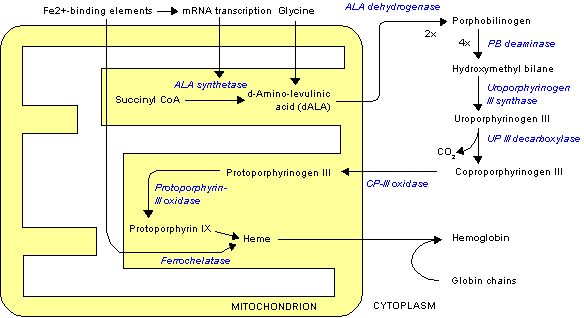WBR1006
| Author | [[PageAuthor::Vidit Bhargava, M.B.B.S [1]]] |
|---|---|
| Exam Type | ExamType::USMLE Step 2 CK |
| Main Category | MainCategory::Pharmacology |
| Sub Category | SubCategory::Dermatology |
| Prompt | [[Prompt::A 35 year old female presents with a 2 week history of sensitivity to sunlight. Whenever she steps outside unprotected she develops blistering, scarring, pigmentation on the back of her hands and face. She has also noticed increased hair growth at unusual places during these past 2 weeks. She is sexually active and takes oral contraceptives regularly. The physician orders the following labs:
Complete blood count:
Liver function test's
Urinalysis:
USG: Normal liver architecture The patient is diagnosed with an enzymatic defect in heme metabolism, which of the following indicates the disease and the associated enzymatic defect?]] |
| Answer A | [[AnswerA::Congenital erythropoietic porphyria; uroporphyrinogen III synthase]] |
| Answer A Explanation | [[AnswerAExp::Congenital erythropoietic porphyria is characterized by the deficiency of enzyme uroporphyrinogen III synthase in heme pathway.
The three main symptoms that are present in patients with this disease are:
Abdominal pain may sometimes occur with acute onset. Exposure to the sunlight can cause discomfort and result in blistering, consciousness of heat, and swelling and redness of the skin. After an attack urine can become a reddish or brown color. Some attacks can cause life-threatening issues to arise, such as low blood pressure, extreme electrolyte imbalances and shock.]] |
| Answer B | [[AnswerB::Porphyria cutanea tarda; uroporphyrinogen III decarboxylase]] |
| Answer B Explanation | [[AnswerBExp::It is the most common subtype of porphyria, caused by deficiency of enzyme uroporphyrinogen III decarboxylase . Patients present with photosensitivities in the form of blisters and erosions on commonly exposed areas of the skin. This is usually observed in the face, hands, forearms, and lower legs. Other skin manifestations like hyperpigmentation and hypertrichosis also occur. Chronic liver problems are extremely common, these include hepatic fibrosis (scarring of the liver), cirrhosis, and inflammation. Additionally, patients will often void a wine-red color urine with an increased concentration of uroporphyrin I due to their enzymatic deficiency.]] |
| Answer C | [[AnswerC::Acute intermittent porphyria (AIP); porphobilinogen deaminase]] |
| Answer C Explanation | [[AnswerCExp::It is the second most common type of porphyria caused due to deficiency of the enzyme porphobilinogen deaminase.
Symptoms in AIP can be variable. They include:
Rash is not typically seen in AIP. Urine of AIP sufferers may turn dark purple when exposed to ultraviolet light and air after 24 hours of exposure. It is due to conversion of porphobilinogen to the dark colored porphobilin due to oxygen exposure.]] |
| Answer D | [[AnswerD::Variegate porphyria; protoporphyrinogen oxidase]] |
| Answer D Explanation | [[AnswerDExp::The disorder results from low levels of the enzyme protoporphyrinogen oxidase.
Mostly asymptomatic, when symptoms occur, they can include acute attacks (similar to acute intermittent porphyria), skin damage, or both. Acute attacks usually begin in adulthood and cause abdominal pain, vomiting, diarrhea and constipation. During an attack, a person may also experience muscle weakness, seizures, and mental changes such as anxiety and hallucinations. These signs and symptoms are triggered by nongenetic factors such as certain drugs, dieting or fasting, certain hormones and stress. Some people with variegate porphyria have skin that is overly sensitive to sunlight. Areas of skin exposed to the sun develop severe blistering, scarring, changes in pigmentation, and increased hair growth. Exposed skin becomes fragile and is easily damaged.]] |
| Answer E | [[AnswerE::Acute porphyria; ALA dehydrogenase deficiency]] |
| Answer E Explanation | [[AnswerEExp::It is a rare condition, caused due to ALA dehydrogenase deficiency, primarily affect the nervous system, resulting in abdominal pain, vomiting, acute neuropathy, muscle weakness, seizures and mental disturbances, including hallucinations, depression, anxiety and paranoia. Cardiac arrhythmias and tachycardia may develop as the autonomic nervous system is affected. Pain can be severe and can, in some cases, be both acute and chronic in nature. Constipation is frequently present, as the nervous system of the gut is affected, but diarrhea can also occur.]] |
| Right Answer | RightAnswer::B |
| Explanation | [[Explanation::The image shown below represents heme synthesis:
Each of the enzymes are associated with deficiency disorders, each having a specific presentation. |
| Approved | Approved::Yes |
| Keyword | WBRKeyword::Porphyria, WBRKeyword::heme synthesis |
| Linked Question | Linked:: |
| Order in Linked Questions | LinkedOrder:: |
